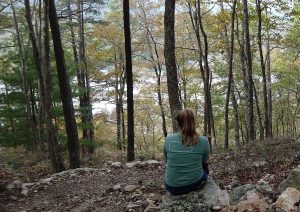The study of ecology requires a connection and understanding of the natural world. Deep study of the natural world can reveal amazing patterns; but in our technology soaked lives, many of us don’t have the inclination or the opportunity to connect to the natural world. This semester-long assignment offers the opportunity to disconnect from technology, to be quiet, to observe a natural spot on campus (or in a place you can get to regularly), and to connect to the broader world.

The best qualities of a sit-spot are:
- Easy to get to
- Has nature and low foot traffic
- You feel safe and comfortable
The ritual process to follow when you enter your sit-spot:
1. TUNE IN: Your goal is to consciously tune yourself into the patterns of nature. This is NOT a time to ZONE OUT. Below are suggestions on how to TUNE IN. It is harder than you think and will take constant attention. But it will be worth it!
HOW TO TUNE IN:
- Enter your sit-space slowly. Frame your mind when you are 100 yards away from your spot. Try to put all of your other obligations to the side and focus on the task at hand. You need to settle your mind and SLOW DOWN. Do this by walking those last 100 yards slowly, with intention, training your mind by slowing your body.
- Turn off your phone – put it away. You should NOT look at it or CHECK it. I imagine you will be tempted to cheat – snatch a glance or two at your phone – but if you do this then you are defeating the purpose of the assignment. So DON’T CHEAT!
- Relax your breathing and try to settle your mind.
- Once you arrive at your sit-spot get comfortable. Bring a pad, blanket or bag to sit on. Take a deep breath.
- Now close your eyes, focus on your breathing. Take a few minutes to systematically focus on each one of your senses. With your eyes closed, take a few minutes to listen to the world around you. With eyes still closed, take a few minutes to focus on what you smell and then to what you feel. Finally, open your eyes and focus on what you see.
- Try to tune in to all your senses. Look at things around you – look at the color, the activity. If you see a bird can you describe it in your mind so that someone else would know what you are seeing? What does that tree in front of you really look like – are you seeing a cartoon version of a tree or really seeing it?
- Once you are settled and tuned in (this could take from 5-10 minutes) begin your quiet observations.
2. 15 minutes of quiet observation: For the next 15 minutes you need to just be present – don’t write anything down. Just focus on the here and now in your sit spot. Dismiss the noise and stories in your mind as they creep in and beg for attention. Choose to not listen to that noise and focus.
What do you see? Can you really see it? What do you hear? Can you describe these sounds? What does the sky look like? What does the air smell like? What stories are there in this landscape that if you weren’t being intentionally present you would not know? Are there any animals moving around – look at the ground at the bushes at the trees? What are the seasonal changes since the last time you were here in your space & since the first time you sat here? What are the changes inside yourself? Ask yourself these questions and others. Observe, feel and be quiet.
3. Guided Questions: When at least 15 minutes of focused time has elapsed (please feel free to go longer), you should pull out your guided questions and your notebook. You should remain in your sit-spot and respond/answer the questions in your field journal. You will use these notes for your BLOG post. While these notes are primarily for your use, you will be asked to periodically turn in your journal.
4. Take pictures of your sit spot: After you have completed your journaling, you should pull out your phone and take pictures of your spot. Take lots of pictures – you will be directed to take some particular photos in your guided questions, but you are encouraged to capture more.
